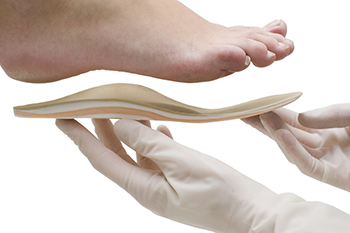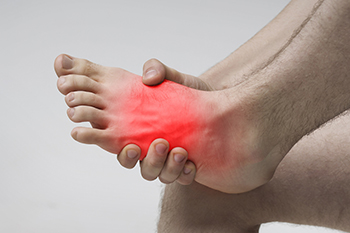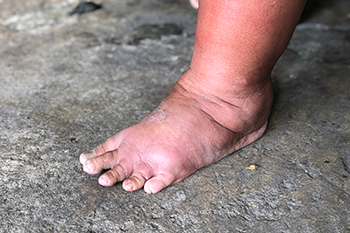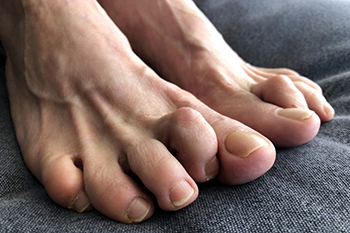Langley (604)-530-1561
Fax (778)-278-1561
Email podiatry@urton.ca
July 2022
Does Your Child Need Orthotics?

As a child grows and navigates their way through their youth, they may experience any number of foot problems. For example, your child may complain to you about having foot pain as a result of having flat feet. Consequently, your child might have sunken arches in their feet and turn their feet inward when walking. One important way in which you might be able to help improve the condition of your child’s feet is with orthotics. These custom-made shoe inserts can be made to exactly fit your child’s specific foot, and are made to help correct their gait. Namely, orthotics for children with flat feet are designed to have arch support cushions that encourage their feet not to collapse into the ground when walking. Additionally, orthotics for children with flat feet also have heel cushions that are intended to strengthen the ankles. These shoe inserts can be utilized in many different kinds of spacious footwear for children. Orthotics are not just for children – they have been effective in correcting the gaits of individuals of all ages as well. When it comes to protecting the health of your child’s feet, it is best not to take chances and to be proactive in preventing injuries. It is highly suggested to see a podiatrist for more information about orthotics.
If you are having discomfort in your feet and would like to try orthotics, contact William Urton, DPM from British Columbia. Our doctor can provide the care you need to keep you pain-free and on your feet.
What Are Orthotics?
Orthotics are inserts you can place into your shoes to help with a variety of foot problems such as flat feet or foot pain. Orthotics provide relief and comfort for minor foot and heel pain but can’t correct serious biomechanical problems in your feet.
Over-the-Counter Inserts
Orthotics come in a wide variety of over-the-counter inserts that are used to treat foot pain, heel pain, and minor problems. For example, arch supports can be inserted into your shoes to help correct overarched or flat feet, while gel insoles are often used because they provide comfort and relief from foot and heel pain by alleviating pressure.
Prescription Orthotics
If over-the-counter inserts don’t work for you or if you have a more severe foot concern, it is possible to have your podiatrist prescribe custom orthotics. These high-quality inserts are designed to treat problems such as abnormal motion, plantar fasciitis, and severe forms of heel pain. They can even be used to help patients suffering from diabetes by treating foot ulcers and painful calluses and are usually molded to your feet individually, which allows them to provide full support and comfort.
If you are experiencing minor to severe foot or heel pain, it’s recommended to speak with your podiatrist about the possibilities of using orthotics. A podiatrist can determine which type of orthotic is right for you and allow you to take the first steps towards being pain-free.
If you have any questions please contact our office located in Langley, BC . We offer the newest diagnostic and treatment technologies for all your foot and ankle needs.
Causes of Foot Stress Fractures

Stress fractures in the foot are usually the result of overuse or repetitive activities. They are common among runners, basketball and soccer players, and dancers. Women who are experiencing osteoporosis are also at risk. Foot stress fractures affect three main areas: the 2nd and 3rd metatarsals, the navicular bone at the top of the foot, and the calcaneus bone in the heel. Stress fractures may be difficult to detect because they are tiny hairline cracks in the bones and may easily be missed in an X-ray. Because they usually develop over time and are not immediately painful, stress fractures often go undetected or are mistaken for plain old sore feet. These fractures are caused by any activity that puts too much stress on the bones. Among the causes are increasing the frequency or length of an activity too quickly, changing from a soft to hard surface, using a faulty technique that may be the result of other conditions, and utilizing improper footwear. Even non-athletes experience stress fractures when walking too far or for too long while on vacation. If constant foot pain causes you to believe you may have developed stress fractures of the foot, please visit a podiatrist for a complete exam and diagnosis.
Activities where too much pressure is put on the feet can cause stress fractures. To learn more, contact William Urton, DPM from British Columbia. Our doctor can provide the care you need to keep your pain free and on your feet.
Dealing with Stress Fractures of the Foot and Ankle
Stress fractures occur in the foot and ankle when muscles in these areas weaken from too much or too little use. The feet and ankles then lose support when walking or running from the impact of the ground. Since there is no protection, the bones receive the full impact of each step. Stress on the feet can cause cracks to form in the bones, thus creating stress fractures.
What Are Stress Fractures?
Stress fractures occur frequently in individuals whose daily activities cause great impact on the feet and ankles. Stress factors are most common among:
- Runners
- People affected with Osteoporosis
- Tennis or basketball players
- Gymnasts
- High impact workouts
Symptoms
Pain from the fractures occur in the area of the fractures and can be constant or intermittent. It will often cause sharp or dull pain with swelling and tenderness. Engaging in any kind of activity which involves high impact will aggravate pain.
If you have any questions please feel free to contact our office located in Langley, BC . We offer the newest diagnostic and treatment technologies for all your foot and ankle needs.
What Swollen Feet Might Mean

Peripheral edema is another name for swollen feet. It is a gathering of fluid in the tissue of the feet. Swollen feet might be a sign that something is happening in your body that requires attention. Because feet are so important to our mobility and functioning, taking care of them is crucial. Swollen feet might be caused by prolonged inactivity, walking for too long, being in hot or humid weather, hormone fluctuations, pregnancy, a foot injury (sprain, fracture, torn ligament, or tendon), or a serious underlying medical condition. Arthritis, lymphedema, congestive heart failure, deep vein thrombosis, a bacterial infection, or kidney disease are all serious health conditions that can result in edema. If your feet are swollen and you do not know why, if you are in pain, or if you have a medical condition that can cause swollen feet, please consult with a podiatrist who can help you get to the root of the problem, and provide proper treatment.
Swollen feet can be a sign of an underlying condition. If you have any concerns, contact William Urton, DPM of British Columbia. Our doctor can provide the care you need to keep you pain-free and on your feet.
Swollen feet are a common ailment among pregnant women and people who stand or sit for extended periods. Aging may increase the possibility of swollen feet and patients who are obese often notice when their feet are swelling too. There may be medical reasons why swollen feet occur:
- Phlebitis - A condition that causes the veins to become inflamed and can also cause leg pain.
- Liver disease - This may lead to low blood levels of albumin which is a protein. This can cause fluid in the blood to pass into the tissues and several areas of the body can become swollen.
- Heart failure - When the heart doesn’t pump properly the blood that is normally pumped back to the heart can pool in the veins of the legs causing swollen feet.
- Kidney disease - One of the main functions of the kidneys is releasing excess fluid in the body. This type of condition can make it difficult for the kidneys to function properly, and as a result the feet may become swollen.
- Deep-vein thrombosis (DVT)- This is a serious condition where blood clots form in the veins of the legs. They can block the return of blood from the legs to the heart which may cause the feet to swell. It is important to be treated by a podiatrist if this condition is present.
Swollen feet can also be caused by bone and tendon conditions, including fractures, arthritis, and tendinitis. Additionally, there may be skin and toenail conditions and an infection may cause the feet to swell. Patients who take medicine to treat high blood pressure may be prone to getting swollen feet.
Many patients elevate their feet to help relieve the swelling and this is generally a temporary remedy. When a podiatrist is consulted the reason behind the swelling can be uncovered and subsequently treated.
If you have any questions please feel free to contact our office located in Langley, BC . We offer the newest diagnostic tools and technology to treat your foot and ankle needs.
Why Live with Pain and Numbness in Your Feet?
What Type of Shoes to Avoid With Hammertoe

A deformity affecting the second, third, or fourth toe can be referred to as hammertoe. This condition causes one or more of these toes to bend downward at the middle joint. Hammertoe can develop from wearing shoes that do not have adequate room for the toes to move freely, which often includes high heels. In some cases, the affected toes can be manipulated into their normal position as long as they are somewhat flexible. Surgery may be a necessary treatment option for less flexible joints and this often results in permanent straightening. Many patients have to purchase shoes that can accommodate their deformed toes. Corns and calluses can form on top of the joints as the toes rub against the top of the shoe. Some patients also experience pain from calluses that form on the sole of the foot. This can happen due to the chronic stress placed on the foot from the deformed toe. Hammertoe is a foot condition that is treated by a podiatrist and it is strongly suggested that you consult with this type of doctor if you are affected by this ailment.
Hammertoe
Hammertoes can be a painful condition to live with. For more information, contact William Urton, DPM from British Columbia. Our doctor will answer any of your foot- and ankle-related questions.
Hammertoe is a foot deformity that affects the joints of the second, third, fourth, or fifth toes of your feet. It is a painful foot condition in which these toes curl and arch up, which can often lead to pain when wearing footwear.
Symptoms
- Pain in the affected toes
- Development of corns or calluses due to friction
- Inflammation
- Redness
- Contracture of the toes
Causes
Genetics – People who are genetically predisposed to hammertoe are often more susceptible
Arthritis – Because arthritis affects the joints in your toes, further deformities stemming from arthritis can occur
Trauma – Direct trauma to the toes could potentially lead to hammertoe
Ill-fitting shoes – Undue pressure on the front of the toes from ill-fitting shoes can potentially lead to the development of hammertoe
Treatment
Orthotics – Custom made inserts can be used to help relieve pressure placed on the toes and therefore relieve some of the pain associated with it
Medications – Oral medications such as anti-inflammatories or NSAIDs could be used to treat the pain and inflammation hammertoes causes. Injections of corticosteroids are also sometimes used
Surgery – In more severe cases where the hammertoes have become more rigid, foot surgery is a potential option
If you have any questions please contact our office located in Langley, BC . We offer the newest diagnostic and treatment technologies for all your foot and ankle needs.








